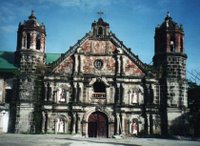 In the Kapampangan language, churches are called pisamban. One of the very first websites I made way back in college was on the churches of Pampanga. I remember that I spent two weeks traveling around the province of Pampanga searching for its heritage sites. At that time, there was no inventory of heritage sites. And the information and photos I collected eventually became the jump off point for the heritage conservation campaign in Pampanga.
In the Kapampangan language, churches are called pisamban. One of the very first websites I made way back in college was on the churches of Pampanga. I remember that I spent two weeks traveling around the province of Pampanga searching for its heritage sites. At that time, there was no inventory of heritage sites. And the information and photos I collected eventually became the jump off point for the heritage conservation campaign in Pampanga.This I made available on the net through the website Pisamban: Churches of Pampanga (as of October 2009, Geocities is no longer online) among others. I was no longer able to update it since the files were lost when my computer crashed several years back. Above is a photo of the Minalin Church while the one below can be found in San Luis. Anyway, there are more photos of Pampanga and San Fernando heritage churches and other structures in my Yahoo! Photos.
 Just to update everyone regarding our petition to the CBCP, we've collected more than 500 signatures to date and more are still coming in. It has been gaining so much momentum, international attention and support is pouring in as well. We have received letters of support from international conservation agencies such as the World Monuments Fund, the International Council on Monuments and Sites (ICOMOS) and its various national committees worldwide, and the Partners for Sacred Places among many others. If you haven't signed yet, please do at http://www.petitiononline.com/cbcp.
Just to update everyone regarding our petition to the CBCP, we've collected more than 500 signatures to date and more are still coming in. It has been gaining so much momentum, international attention and support is pouring in as well. We have received letters of support from international conservation agencies such as the World Monuments Fund, the International Council on Monuments and Sites (ICOMOS) and its various national committees worldwide, and the Partners for Sacred Places among many others. If you haven't signed yet, please do at http://www.petitiononline.com/cbcp.The Vatican actually has a Pontifical Commission for the Cultural Heritage of the Church. In a 2001 circular letter, its president His Eminence Francesco Cardinal Marchisano says, "The cultural treasures of the Church make up the specific patrimony of the Christian community. At the same time, as a result of the universal dimension of the Christian message, they belong to the whole of humanity. Their end is the same as the Church's mission in its twofold work of Christian evangelization and promoting the human being. Their value lies in highlighting the activity of inculturating the faith. (emphasis mine)"
He adds, “The value that the Church places on her cultural goods explains ‘the will on the part of the community of faithful, and in particular ecclesiastical institutions, to gather since the apostolic period the testimonies of faith and nourish their memory, express the uniqueness and continuity of the Church that lives out these last periods of history’ (Pontifical Commission for the Cultural Heritage of the Church, Circular Letter The Pastoral Function of Church Archives, see n. 1.1.). Thus, the Church considers as crucial the handing down of her own patrimony of cultural goods. They represent, in fact, an essential link in the chain of Tradition; they are the visible memory of evangelization; they become a pastoral instrument. It follows therefore the effort ‘to restore, preserve, catalogue, and protect’ them (John Paul II, Address of October 12, 1995, see n. 4) in order to assure that they are treasured, ‘thus promoting a greater knowledge and suitable use in catechesis and in the liturgy’ (ibid.). (emphasis mine again)”

Ivan, nobody makes me see how beautiful our country is the way that you do. Thanks for sharing all your experiences and travels.
ReplyDeleteThanks Jairam! Do keep on visiting the blog.
ReplyDeleteFantastic blog. Having moved from the Philippines to Australia when I was too young to appreciate the beauty of the country, I feel like your blog is enabling me to travel around my homeland without actually doing it & paying for it.
ReplyDeleteThanks!
thanks to councilor lavina... got your blog address from his. nice to know a fellow blogger blogging about our beloved philippines. keep on blogging... this is not only for us but for the generations to come. mabuhay! zimm
ReplyDelete